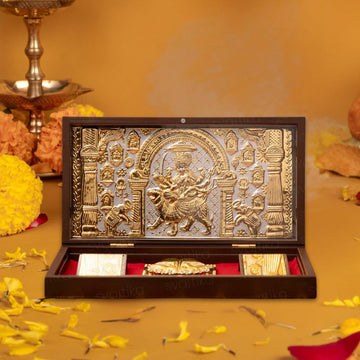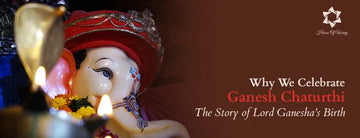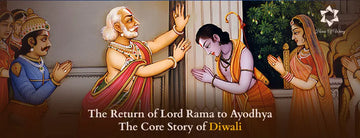Why We Celebrate Ganesh Chaturthi | Story of Lord Ganesha’s Birth
Do you remember those days when Ganesh Chaturthi was more than just a day? Preparations started a month in advance. Markets were full of vendors selling Lord Ganesha Idols. You'd wake up to the sound of dhol, race to see the newly arrived idols, singing “Oh my friend Ganesha,” from that amazing song, and feel like Bappa was actually your friend.
Ganesh Chaturthi was all about sweets, decorations, and pure joy. Now, as we grow, we begin to think about the story of our beloved Bappa. What is the true Ganesh Chaturthi significance? And why do we celebrate Ganesh Chaturthi with so much dedication every year?
Let's go right back to the beginning - to the heart of the Lord Ganesha birth story, to the meaning of his form, and understand why the Ganpati festival was so special.
The Birth Story of Lord Ganesha: Mythological Background
The story of the birth of Lord Ganesha is one of the most interesting stories in Hindu mythology. Lord Ganesha is also known as Vinayaka and is worshipped for his ability to remove obstacles and as the God of wisdom, intelligence, and prosperity. The story of Ganesha's entry into this world, which is included in the Shiva Purana, is rich in symbolism.
- Goddess Parvati's Creation: In the story, Goddess Parvati built Ganesha from the sandalwood paste that she was using to take a bath. After making the shape of a boy, she breathed life into him and told him to guard the door while she bathed.
- Lord Shiva's Encounter: Meanwhile, Lord Shiva returned and was trying to come in, but the young boy did not know who Lord Shiva was. Ganesha blocked Lord Shiva from entering his own house. Shiva got angered and chopped the young boy's whole head off.
- Parvati's Anger: When Parvati found out about this, she was so angry and felt insulted that she decided to destroy the entire Creation. Lord Brahma, being the Creator, must have been greatly worried and asked her to reconsider her drastic plan. Parvati agreed, but only if two conditions were accomplished: one was that Ganesha would be restored to life, and the second was that he would be worshipped before all gods.
- The Elephant Head: At this point, when Shiva accepted what he had done, he vowed to bring the boy back to life. He used the head of the first living creature he came across, which was an elephant, and thus Ganesha was given the form that everybody loves.
The story of the birth of Lord Ganesha has teachings of respect, working at something with devotion, and achieving Divinity.
The Role of Goddess Parvati and Lord Shiva in Ganesha’s Creation
In Ganesha’s creation, the union of Goddess Parvati and Lord Shiva reflects the ideal balance of Shakti, the divine energy that creates life, and Shiva, the pure consciousness that shapes and transforms.
- Parvati has the power of nurturing, creating, and protecting.
- Shiva has the power of transformation and is the remover of ignorance.
The union of these two powers creates a balance, from which Ganesha emerged as a God who is truly wise, humble, and strong.
Symbolism Behind Lord Ganesha’s Elephant Head
Lord Ganesha’s elephant head is not only a physical appearance, but it also has a divine and spiritual meaning:
- Large ears: It teaches us to listen more and speak less.
- Small eyes: Tell us to look at the situation, without missing the details.
- The trunk: Shows how one can be adaptable in life, strong enough to uplift a tree, gentle enough to pick up a flower.
- A big head: Think BIG and wise.
- A single tusk: Keep the good, forget the bad.
The symbolism of Ganesh’s elephant head reminds us to live with understanding and balance.
Spiritual Significance of Celebrating Ganesh Chaturthi
The Ganesh Chaturthi significance is not just about decorations and prayers; it's about celebrating wisdom, removing obstacles, and welcoming auspiciousness into our lives.
Ganesh Chaturthi is all about:
- New Beginnings: Ganesha is worshipped before any new work, as he is the Vighnaharta (remover of obstacles).
- Inner Purification: Just like we clean our house to welcome God, we also need to clean our minds and hearts to invite peace and harmony.
- Unity in Community: The Spiritual meaning of the Ganesh Chaturthi celebration was originally organised to bring people together in 1893 as a community event against British rule.
This is why even today, Ganesh Utsav celebrations remain one of the most popular community events across India.
Ganesh Chaturthi Rituals: From Idol Installation to Visarjan
The Ganesh puja celebrations come with lots of traditions & beliefs. Devotees bring home lord ganesha idols for 1.5, 5, 7, or 11 days as per Ganesh Chaturthi traditions.
Some of the Ganesh puja rituals are
- Welcoming Bappa (Pranapratishtha): Bhakts bring the Dagdusheth Ganesha idols to the home or village pandals with love and devotion. After this, the priest will perform the rituals that bring life into the idol.
- Daily Worship (Shodashopachara): The daily puja is performed using 16 elements, such as flowers, incense sticks, diyas, fruits, and modak for Lord Ganesha.
- Mantra and Aarti: The devotees practice Ganesha mantra chanting, sing devotional songs to bring divine energy into the home.
- Final Aarti: Grand pooja is organised at home or pandals before visarjan. Before visarjan, you might have seen your grandmother tying red cloth around the Lord Ganesha Idol. The food is typically wrapped in a red cloth along with Modak, coconut, and jaggery as a symbolic offering for his journey back to Kailash Parvat.
- Ganesh Visarjan: The festival ends with the immersion (visarjan) of the idol in the water. Bhakts usually get emotional during visarjan, as Bappa is finally said goodbye until next year.
The Ganesh Visarjan meaning is about detachment, and it reminds devotees that everything is temporary, yet the spirit is eternal.
Eco-Friendly Ganesh Idols: Rising Awareness and Trends
As we all know, the Ganesh idols are immersed in the water. In recent years, devotees have avoided using idols made up of plaster of paris and have moved towards eco-friendly Ganesh idols made of clay, natural colours, or plantable materials.
These idols:
- Do not harm aquatic life with chemical paints.
- Dissolve in water without leaving toxic substances.
- Some idols also have seeds that sprout into plants after immersion.
The change of these practices shows that devotion can come with environmental responsibility.
Modak and Other Offerings: What Pleases Lord Ganesha?
My Nani used to tell me that Lord Ganesha loves modak a lot, that he is also known as Modakapriya. Every Ganesh Chaturthi, she used to specially prepare modak for Lord Ganesha.
Some of the popular naivedya (offering) include:
- Ukadiche Modak (steamed rice flour dumplings stuffed with coconut-jaggery)
- Laddos
- Fruits
- Durva grass
These offerings signify the sweetness of life and express gratitude for everything.
Regional Variations in Ganesh Chaturthi Celebrations
While the basic traditions of Ganesh Chaturthi celebrations are more or less the same, each region involves its own culture.
- Maharashtra: The Ganesh Utsav is celebrated in memory of freedom fighter Lokmanya Tilak, who organised a grand public event aiming for unity against the British.
- South India: Devotes perform rituals at temples with home-made clay idols, and prepare traditional meals as offerings.
- Goa: Ganesh Chaturthi is celebrated as "Chavath". People usually prepare matoli, bring home idols, and sing traditional songs while playing fugdi (traditional dance).
- Tamil Nadu & Andhra Pradesh: It is known as "Vinayaka Chaturthi". People observe vrat and offer fruits, sweets, and flowers to Ganesha.
Mantras and Aartis Dedicated to Lord Ganesha
Chanting of mantras is practised to align your energies with divine vibrations.
Some common Ganesha mantras are:
-
"Om Gan Ganapataye Namah" is chanted to remove obstacles and bring success.
ॐ गं गणपतये नमो नम:
श्री सिद्धि विनायक नमो नम:
अष्टविनायक नमो नम:
गणपती बाप्पा मोरया ||
-
"Vakratunda Mahakaya" calls on the blessings of wisdom and strength from Ganesha.
वक्रतुण्ड महाकाय सूर्यकोटि समप्रभ
निर्विघ्नं कुरु मे देव सर्वकार्येषु सर्वदा
वक्रतुण्ड महाकाय सूर्यकोटि समप्रभ
निर्विघ्नं कुरु मे देव सर्वकार्येषु सर्वदा
-
Ganesh Aarti is said daily during the festival to demonstrate devotion.
जय गणेश जय गणेश, जय गणेश देवा।
माता जाकी पार्वती, पिता महादेवा॥
एक दंत दयावंत, चार भुजा धारी।
माथे सिंदूर सोहे, मूसे की सवारी॥…….
Lessons from Lord Ganesha’s Life and Their Relevance Today
The life of Lord Ganesha has many lessons that are applicable in today’s lifestyle:
- Patience and Humility: Despite his power, Ganesha retains his humility.
- Knowledge vs. Speed: The story of Ganesha winning a race around the world, by circling his parents, teaches that being smart is better than being fast.
- Balance: The forms of Ganesha teach that fun and strength must be balanced with gentleness and understanding.
All of those lessons remind us that spirituality is not only about rituals but also about how to live a mindful, balanced life.
Final Take
Ganesh Chaturthi is much more than a festival, a celebration of wisdom and devotion. From his miraculous birth to visarjan, every aspect of Ganesh Chaturthi has a lesson. It teaches us patience, humility, balance, and how to remove obstacles intelligently and gracefully.
Ganpati festival 2025 is on 25th August. Let us all welcome Lord Ganesha Idols with love and devotion. You can explore idols, puja essentials, and Ganesh Chaturthi gifting items on our page, House of Wemy.
May Lord Ganesha remove your obstacles and fulfil all your wishes. Happy Ganesh Chaturthi.










